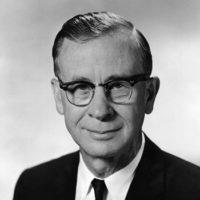
Lyman C. Craig
The Rockefeller Institute
For the countercurrent distribution technique as a method for the separation of biologically significant compounds, and for the isolation and structure studies of important antibiotics.
Through development of principles of separation of chemical compounds by countercurrent distribution, Lyman Craig introduced a method which has made possible the isolation and identification of countless substances that occur in nature and that are synthesized in the laboratory for therapeutic purposes.
The ideas that led Dr. Craig to the development of the countercurrent distribution came as a result of frustrations in structural studies with the alkaloids of ergot and veratrine, during the late 1930s. An apparatus was devised in 1943 which would accomplish, simultaneously, 20 quantitative extractions as a single step in a countercurrent process. Before it could be applied widely to alkaloids, a more pressing problem arose during World War II. A method was needed for proving the purity of new synthetic antimalarials before clinical testing. The crude countercurrent distribution apparatus was tried, and consistently revealed impurity in preparations homogeneous by all other separation techniques. The method quickly became the ultimate analytical tool in the antimalarial program. By 1955, Dr. Craig had in operation a single automatic train with 1000 extraction cells.
The effectiveness of countercurrent distribution in characterizing complex organic solutes was extended to provide a method for determining molecular weights—the method of partial substitution. This method established conclusively the molecular weights of a number of polypeptide antibiotics, and was decisive in showing that the monomer of insulin possessed a molecular weight in the range of 6000 rather than 12,000, the accepted molecular weight at that time. The correct amino acid composition was established for the first time on countercurrent purified material. Both results were crucial to the classical work of Sanger in the establishment of the structure of insulin. Countercurrent distribution has been put to effective use in laboratories throughout the world. In the hormone field it has played a crucial role in the isolation and study of oxytocin, vasopressin, ACTH, growth hormone, lactogenic hormone, melanophore-stimulating hormone, parathyroid hormone and other hormones. It has also proved fruitful in studies on the structure of the tobacco mosaic virus protein, the hemoglobins, angiotensin and other biologically active peptides. It has been more recently extended to work on S-RNA and related compounds, as well as in many other areas of research.
The world of medicine is aware of the enormous good which has come from Dr. Craig's brilliant basic research and recognizes the vital role it has played in the successful outcome of the research of investigators everywhere. Their utilization of his technique has made possible discoveries which have made for important progress in the treatment and prevention of disease.
